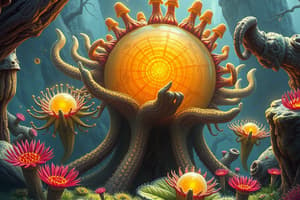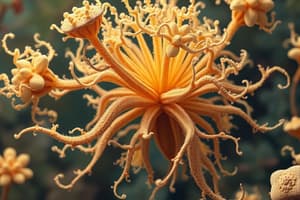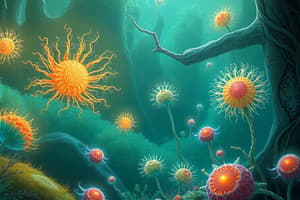Podcast
Questions and Answers
What does the term 'Protista' mean in Greek?
What does the term 'Protista' mean in Greek?
- the mixture
- the unknown
- the very first (correct)
- the very last
Where do most Protista live?
Where do most Protista live?
- In extreme temperatures
- In dry terrestrial environments
- In water, damp terrestrial environments or as parasites (correct)
- In dark places
What is the primary feature of all Protista?
What is the primary feature of all Protista?
- They are heterotrophic organisms
- They are autotrophic organisms
- They are eukaryotic organisms (correct)
- They are multicellular organisms
What is the function of flagella or cilia in some Protista?
What is the function of flagella or cilia in some Protista?
What do scientists speculate about Protista?
What do scientists speculate about Protista?
What is true about the cells of Protista?
What is true about the cells of Protista?
What is characteristic of Protista in terms of nutrition?
What is characteristic of Protista in terms of nutrition?
What is observed in the members of this class?
What is observed in the members of this class?
What is giant kelp?
What is giant kelp?
What do scientists believe about the ancestral relationship between Protista and other kingdoms?
What do scientists believe about the ancestral relationship between Protista and other kingdoms?
Flashcards are hidden until you start studying
Study Notes
Protista
- Protista are simple eukaryotic organisms that are neither plants, animals, nor fungi.
- They are unicellular in nature but can also be found as a colony of cells.
- Most Protista live in water, damp terrestrial environments, or as parasites.
Characteristics of Kingdom Protista
- The primary feature of all Protista is that they are eukaryotic organisms, meaning they have a membrane-enclosed nucleus.
- They are usually aquatic, present in the soil, or in areas with moisture.
- Most Protista species are unicellular organisms, but there are a few multicellular Protista, such as kelp.
- The cells of these species have a nucleus and membrane-bound organelles.
- They can be autotrophic or heterotrophic in nature.
- Symbiosis is observed in the members of this class, such as the relationship between kelp and otters.
- Parasitism is also observed in Protista, such as the species Trypanosoma protozoa that can cause sleeping sickness in humans.
- Protista exhibit locomotion through cilia and flagella, and some have pseudopodia that help them to move.
- Protista reproduce by asexual means, and the sexual method of reproduction is extremely rare and occurs only during times of stress.
Studying That Suits You
Use AI to generate personalized quizzes and flashcards to suit your learning preferences.




